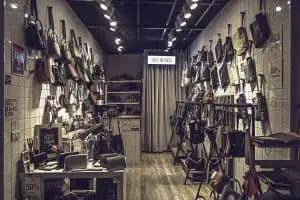What Is Disruptive Innovation?
The term “disruptive” is a word we hear a lot in business, but few people actually know what this term means.
The concept of disruptive innovation was coined by Harvard Professor Clayton Christensen, as a way to define a unique form of innovation capable of broadening access to a product or service to a much wider audience of customers.
It may be helpful to start our reflection by defining the 4 types of innovation that your fashion brand can use to gain a competitive advantage over its competition.
New Product Innovation: Example, The iPhone
This type of innovation is simply connected with launching a new product onto the market.
According to Jobs to Be Done Theory – a marketing framework developed by Prof. Christensen – people’s problems are always the same.
What changes over time are only the tools we use to solve these problems.
In New Product Innovation, companies are able to devise a new solution to an already existing problem and bring it to market to sell at a profit.
In this type of innovation, firms invest a lot of money to fund research and development and then hope to recover from this investment over the life cycle of the product.
At the same time, if a product is truly revolutionary, companies can make money selling it for a much longer amount of time.
In order to do this, however, they need to improve it year after year using the next type of innovation typology: sustaining innovation.
That’s what we are going to discuss in the next section of our post.
Sustaining Innovation: Example, The New Model iPhone
In sustaining innovation, companies try to maximize the profits they have acquired with a new product breakthrough by implementing incremental innovations.
Launching new products in the market can be a hit-or-miss scenario for many brands, and using sustaining innovation can allow firms to keep benefiting from the same product over multiple years by bettering it every year.
In both these types of innovation (New Product Innovation and Sustaining Innovation) organizations need to develop a clear value proposition that connects their product to their target market.
In the next type of innovation, instead, the focus of the innovation will be “simply” based on saving time and money. That’s what we are going to discuss in the next section of our post.
Efficiency Innovation: Example, Banking Apps
In this third category of innovation, called: efficiency innovation, companies use software to create services and products which save customers time and money.
In this case, we are not creating a new product, we are focusing on digitizing or implementing a technological approach to enhance an already established solution.
This type of innovation is very common in the digital start-up environment and if this is something you are interested in pursuing, then this article will help you understand how to get started with developing an app.
Disruptive Innovation: Example, Google
Last but not least, we have disruptive innovation. Disruptive innovation is a type of innovation where a brand, is able to understand a new way of delivering value that allows the company to reach a much broader audience.
Disruptive Innovation is about lowering the cost of access to a product or service, while at the same time, increase its value to the customer. This is in line with another popular framework which is called the Blue Ocean Strategy.
Disruptive Innovation and Blue Ocean Strategy are often used as effective frameworks to test the competitiveness of your fashion brand. If you’d like to read more about this here’s an article for you.
Google is an example of disruptive innovation because, before search ads and display ads showing up on search engines, any company wishing to connect with its customers would have had to resort to much more expensive outbound marketing strategies.
With digital marketing and inbound traffic, brands can connect with their audiences simply by creating content that is relevant and interesting for them.
This approach to communication has become so widespread that many argue that content marketing is the best communication approach for your brand.
Great. Now that we’ve clarified what disruptive innovation is, it’s time to move to the next section of our post where we’ll be looking at 5 different strategies to make your fashion brand disruptive.
How Can Your Fashion Business Be Disruptive?
#1 Use Trickle-Down Theory
The first approach, and one of the most common in fashion, revolves around the idea that brands who are high up in the fashion pyramid and can use their prestige and heritage to develop multiple sub-collection and sub-brands to let the equity of their firms trickle down to the mass market.
Luxury brands beyond haute couture, can develop ready-to-wear collections, diffusion lines, bridge sub-brands, and even sell commodities on the mass market to expand on their target market and potential audience.
Not only that: with second-hand and preowned markets, even vintage clothing has gained incredible value.
If you’d like to explore in more detail the way in which brands spread their value across multiple markets, in this article we’re looking in more detail into that.
Oftentimes brands use the value of their products as a core element of their fashion collections.
By understanding customers’ jobs to be done, brands can differentiate their lines based on the functional, social, and emotional needs of their audience and make sure they can target multiple markets without the risk of diluting the brand.
We discuss the difference between these three sets of values in this article.
What other approaches are possible for fashion brands to conquer multiple markets?
We’re looking into another strategy in the next paragraph, by discussing the business model canvas.
#2 Work on Your Business Model
The business model is the internal logic of your brand. It’s the blueprint of how all of the different processes that take place in your organization support the value that your business is delivering to its customers.
In order to understand how to draft a business model, there’s a very useful and effective tool called the Business Model Canvas that can help you go through extensive trial and error until you identify exactly the best way to organize your business and maximize value to your audience.
Some pioneering organizations like Rent the Runway have been able to use their business model as an opportunity to reflect on a way in which they could increase access to premium designer clothing while making the process of accessing top brands much cheaper.
Rent the Runway developed a collaborative consumption model where customers rent instead of purchasing clothing.
By supporting clothing rental, many more customers can afford to dress sharp, and the organization can make money while reducing fashion pollution.
Business-model thinking can really help your brand identify ways to expand on its market and create opportunities to build shared value.
If you’d like to see these first two approaches in action, we have a perfect example. Take a look at this Giorgio Armani Case Study to see how the Italian brand was able to use the business model framework to access international markets.
#3 Focus on Social Impact
Another dimension of disruption is connected to pursuing social and environmental causes.
By crossing over the typical distinction of for-profit and not-for-profit organizations, many fashion brands are taking bold stances in social and environmental causes.
Companies like Good American have been able to identify a value proposition so relevant and valuable and meaningful, that by standing up for plus-sized women the brand has been able to expand on the audience of women that buy denim.
There are a lot of inspiring examples when it comes to fashion brands driven by social and environmental goals, and their ability to make a mark in the industry is learning many analysts to question whether brands should include social and environmental returns on investment when managing a fashion business.
#5 Use Your Client to Design, Produce and Use
Some brands have tapped into the potential of the internet and developed successful organizations by taking advantage of crowdsourcing.
Involving your audience in every step of the management of your fashion firm can be a way to source a lot of manpower.
Companies like Threadless have been trailblazers in this approach to fashion by using their community as a source of inspiration for t-shirt designs, as a sounding board to select the designs which should be produced, and finally as a community of creatives that will buy the products.
Of course, these are only some of the most common practices, but you can come up with your own creative vision of how to bring fashion experiences to every possible customer.
Great! Now that we’ve covered all relevant bases, let’s draw some conclusive remarks.
Conclusions
There you have it. In this post, we’ve looked at 4 different strategies to develop a disruptive fashion brand. If this is a topic you’re interested in exploring further, then in this article we’re looking at some advice concerning the things many entrepreneurs wished they knew before starting a business. Enjoy!
If you’re interested in the fashion business, don’t hesitate to look into our blog for many more articles on innovation and entrepreneurship.








